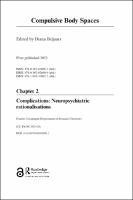Chapter 2 Complications
Proposal review
Neuropsychiatric rationalisations
| dc.contributor.editor | Beljaars, Diana | |
| dc.date.accessioned | 2022-06-22T12:13:45Z | |
| dc.date.available | 2022-06-22T12:13:45Z | |
| dc.date.issued | 2022 | |
| dc.identifier.uri | https://library.oapen.org/handle/20.500.12657/57083 | |
| dc.description.abstract | The confusions live on as the neuropsychiatric sciences cannot answer all questions individuals with compulsive sensibilities may have. Chapter 2 outlines that current knowledge of Tourette’s-related compulsions is minimal, which, as a medicalised phenomenon, is mainly a result of the onto-epistemological structures that govern the neurosciences, psychiatry and psychology that study Tourette syndrome. It elaborates on how these structures create an impasse in the study of compulsions as such, but also as connected to the bodily surroundings. Furthermore, it problematizes the current limited involvement in research of people with Tourette’s who perform and experience the various circumstances of compulsions. Based on this critical review of these life sciences the argument in Chapter 2 identifies four transformations people’s understanding of compulsivity goes through, and sets out how a de-problematisation of the bodily action helps to expand research horizons. | en_US |
| dc.language | English | en_US |
| dc.subject.other | compulsive bodies, compulsive geographies, geographies of health, compulsive spaces | en_US |
| dc.title | Chapter 2 Complications | en_US |
| dc.title.alternative | Neuropsychiatric rationalisations | en_US |
| dc.type | chapter | |
| oapen.identifier.doi | 10.4324/9781003109921-3 | en_US |
| oapen.relation.isPublishedBy | 7b3c7b10-5b1e-40b3-860e-c6dd5197f0bb | en_US |
| oapen.relation.isPartOfBook | 12fa6147-ca55-4342-a95a-dd5df7dd6b36 | en_US |
| oapen.relation.isFundedBy | df9f651c-412a-4a71-a6cb-fd8d32c3c0cb | en_US |
| oapen.relation.isbn | 9780367626082 | en_US |
| oapen.relation.isbn | 9780367626099 | en_US |
| oapen.imprint | Routledge | en_US |
| oapen.pages | 22 | en_US |
| oapen.remark.public | Funder name: Geography Department - Swansea University | |
| peerreview.anonymity | Single-anonymised | |
| peerreview.id | bc80075c-96cc-4740-a9f3-a234bc2598f1 | |
| peerreview.open.review | No | |
| peerreview.publish.responsibility | Publisher | |
| peerreview.review.stage | Pre-publication | |
| peerreview.review.type | Proposal | |
| peerreview.reviewer.type | Internal editor | |
| peerreview.reviewer.type | External peer reviewer | |
| peerreview.title | Proposal review | |
| oapen.review.comments | Taylor & Francis open access titles are reviewed as a minimum at proposal stage by at least two external peer reviewers and an internal editor (additional reviews may be sought and additional content reviewed as required). |

